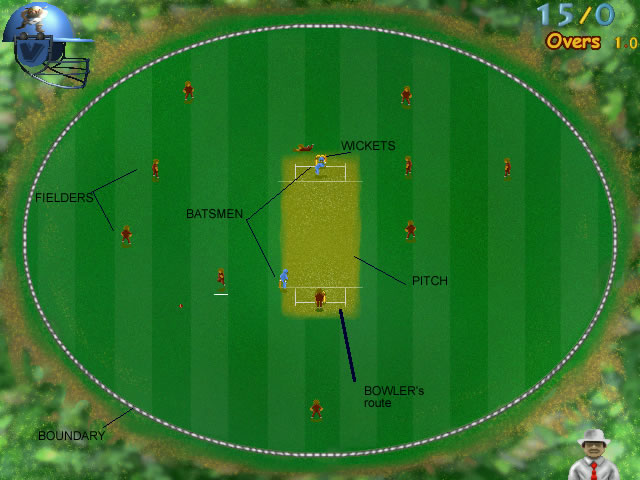
PROJECT 2 - CRICKET MUSEUM EXHIBIT
HYPERLINKS :
STORYBOARDS SCREENSHOTS TIMELINE & TASKS LINK FOR CODE & ART Q/A - LINK
THE GAME
A brief description of the game of cricket, the rules and forms of the game would serve as a starting point for this page. They have been laid out in the fashion of an analogy drawn to other sports in general :
Number of players ( in each side ) : 11
Roles played by them : BATSMEN, BOWLERS, FIELDERS
Elements : Wickets, Cricket ball, Cricket bat, Pitch, Boundary.
Referees: 3 people (Umpire, Leg Umpire, Third Umpire -- relatively new rule)
Shape of playing field: Mostly Oval, ellipsoidal, sometimes.. a square. [ But, the boundary that is marked .. is always a ellipse ]
A graphical look at a cricket stadium

Innings:
There are two formats of the game. 1. TEST 2. ODI (One Day Internationals)
TEST -- 4 Innings
ODI -- 2 Innings
While one team bats and scores runs, the other team bowls to them. Once a target is set, the second team has to chase that down.
Scoring and Bowling :
Bowlers bowl one OVER each, ONE OVER consists of 6 balls aimed at the wickets. The batsman has to protect his wickets
and at the same time, score runs by hitting the ball to all parts of the ground.
IF the BALL crosses the BOUNDARY along the ground -- 4 Runs are awarded to the batting team
IF the BALL crosses the BOUNDARY over the ground -- 6 Runs are awarded to the batting team
IF the BALL is hit within the BOUNDARY... The batsmen run to either ends, to score 1, 2 or 3 runs (or even more.. rarely). <The batsmen stay at the end where they are as soon as the ball is returned to the wickets.
THE PITCH
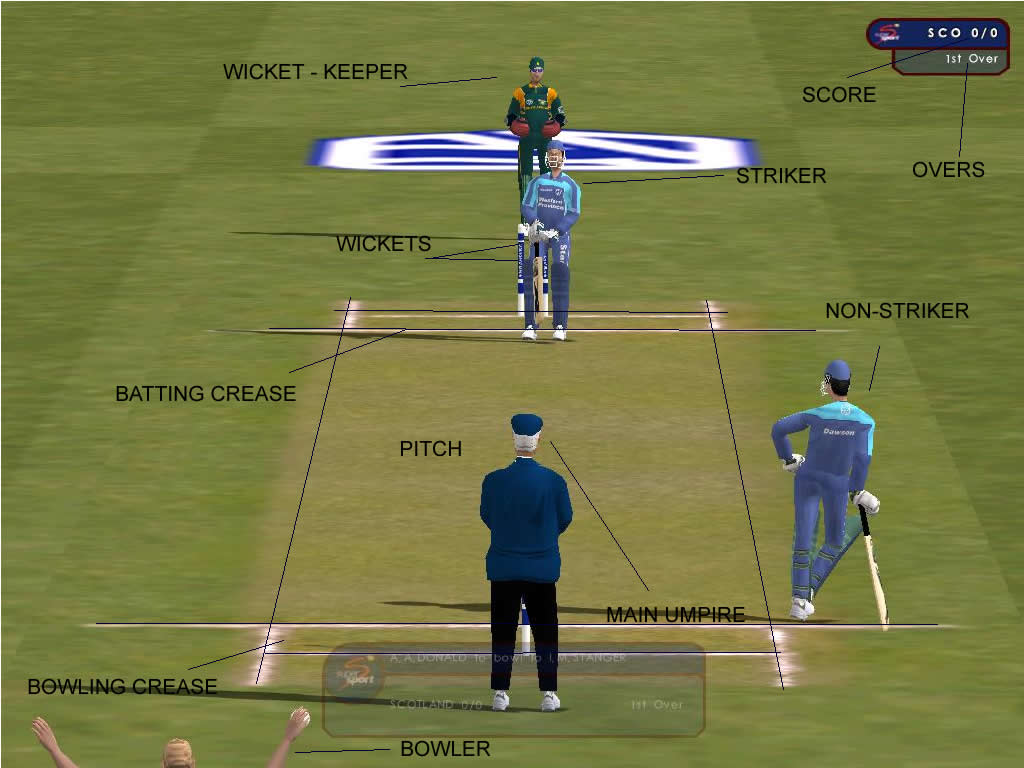
Dimensions of a pitch
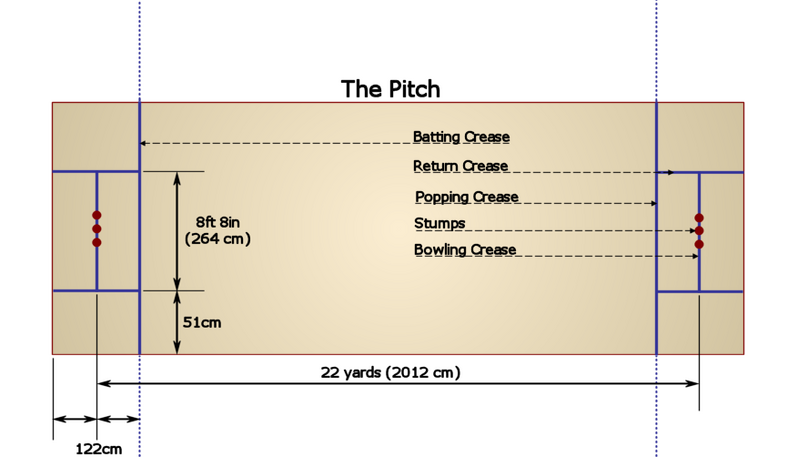
As you can see.. the wickets are also called stumps...
The Wickets in detail...
 The wickets are
placed at two ends of the pitch one for each batsman. Each cylindrical stick
is called "A STUMP". And the name of each STUMP is designated RELATIVE
to the batsman. To understand the nomenclature of cricket stumps, we first need
to understand "LEG SIDE" and "OFF SIDE" with respect to
the field.
The wickets are
placed at two ends of the pitch one for each batsman. Each cylindrical stick
is called "A STUMP". And the name of each STUMP is designated RELATIVE
to the batsman. To understand the nomenclature of cricket stumps, we first need
to understand "LEG SIDE" and "OFF SIDE" with respect to
the field.
The same picture with different markings has been laid out here
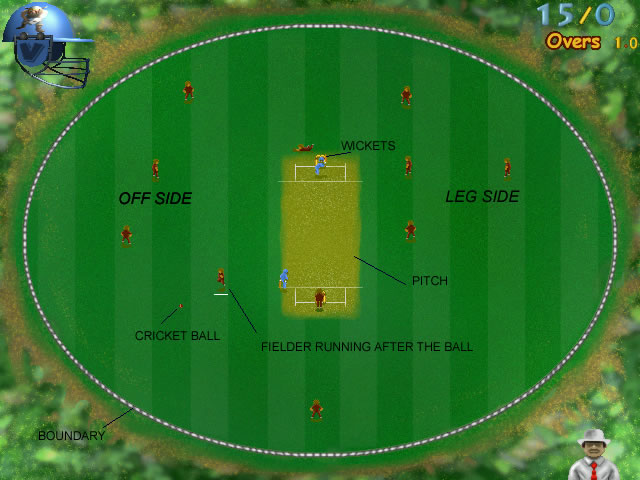 THIS
desgination of LEG-SIDE and OFF-SIDE is for a RIGHT HANDED BATSMAN. For a Left
handed batsman it would be the other way round. IN SIMPLE TERMS.. THE SIDE WHERE
THE BATSMAN'S LEGS ARE is called the LEG SIDE
and the SIDE WHERE is BAT is PLACED is called the OFF
SIDE.
THIS
desgination of LEG-SIDE and OFF-SIDE is for a RIGHT HANDED BATSMAN. For a Left
handed batsman it would be the other way round. IN SIMPLE TERMS.. THE SIDE WHERE
THE BATSMAN'S LEGS ARE is called the LEG SIDE
and the SIDE WHERE is BAT is PLACED is called the OFF
SIDE.
So coming back to the stumps, they are 1. Leg Stump 2. Off Stump 3. Middle Stump -- and the small wooden things placed above them are the "BAILS".
A REAL GAME EXAMPLE - ODI (I am not concentrating on TESTs.. because the longer version is not important in the context of this project)
To explain how an ONE DAY INTERNATIONAL is played, I will lay out a sample scorecard and explain how it goes...
BASICS again...
In ODIs -- There is a 50 Overs limit for each inning.
A Toss decides which team bats or bowls first.
The FIRST batting team posts a TOTAL on the scoreboard.
The SECOND batting team tries to CHASE it down.
A SAMPLE BATTING SCORE CARD --
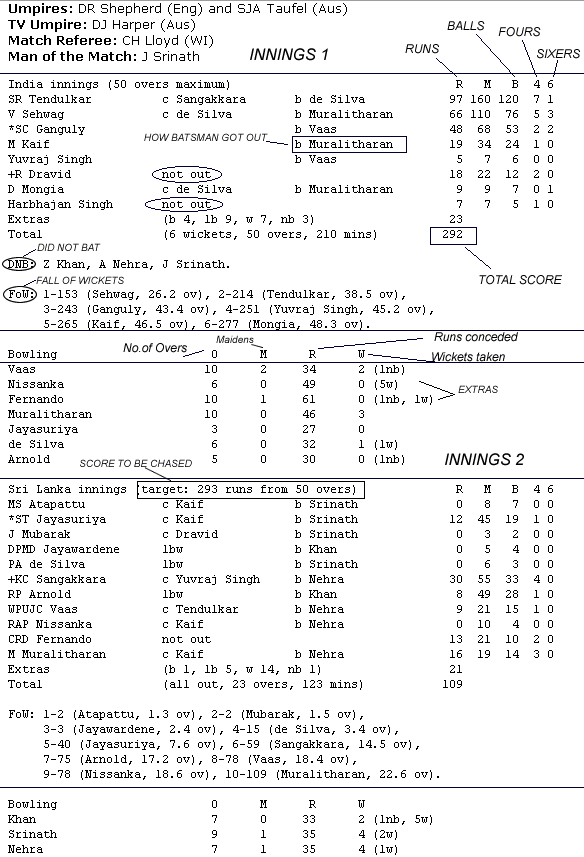
Scorecard Courtesy: http://www.cricinfo.com
SCORE in cricket is counted as RUNS / WICKETS i.e if a score of 212 / 6 is being shown it means that for 212 runs, 6 wickets are down. "wickets are down", means.. that many batsmen are already out. Each team can have 10 wickets. Once all 10 wickets are down, they are "ALL OUT"
Start reading the scorecard from "INDIA innings" ...
Sachin Tendulkar , Virender Sehwag -- Since they are the first two batsmen at the crease, they are called the "OPENERS" -- And you can see that Sachin got out "Caught by Kumar Sangakkara off Aravinda De Silva's bowling" when he was at 97 runs that he made for the team. Similary, Sehwag was out caught. But when you look at the captain, Sourav Ganguly.. he got out in a diiferent manner... i.e he was BOWLED by Chaminda Vaas, of Sri Lanka. Refer the LAW BOOK to understand the different ways of getting out. There are 10 ways of getting out in cricket. I just listed them here:
1. Bowled - Ball hits the wickets (batsman who can't guard his wickets deserves to be OUT!! @#$)
2. Caught - When the ball is hit in the air, if one of the fielders catches it before it hits the ground the STRIKER is again out
3. LBW - The STRIKER uses his legs to defend the wicket when the umpire can clearly see that if he had not done it, the ball would have hit the stumps. (Coward!) Expanded as "Leg Before Wicket".
4. Obstructing the field - I don't know the correct explanation .. refer rulebook
5. Handling the ball - I don't know the correct explanation .. refer rulebook
6. Timed out - I don't know the correct explanation .. refer rulebook
7. Stumped - Too big to explain here.. refer rulebook
8. Run Out - Either the STRIKER or NON-STRIKER can get RUN OUT, if he is stranded in the middle of the pitch and loses his wickets( meaning the fielders hit the wickets with the cricket ball) much more clear explanation .. in the rulebook.
9. Hit the ball twice - Rulebook
10. Hit Wicket - STRIKER hits the wickets with cricket bat or any part of the body. (Now this is what I call "suicide")
The columns for each batsmen, represent the stats as Runs, Minutes,
As you can see.. Rahul Dravid and Harbhajan Singh are not out.
The EXTRAS column specifies the number of runs that the bowling team has conceded in terms of WIDES, NOBALLS, BYES, LEGBYES (refer lawbook).
The TOTAL column nails the most important figures on innings 1 -- 292 Runs for the LOSS of 6 wickets.( you are allowed to lose your wickets only 10 times in an inning)
FoW - Fall Of Wickets denotes the state of the match, when the wickets fell.
If you see the bowling figures of Sri Lanka for innings 1 -- The best bowlers for that session were Vaas ( who conceded just 34 runs in 10 overs -- Economy rate of 3.4 per over and took 2 wickets) and Muralitharan ( who conceded 46 runs, -- econ. rate = 4.6 -- but took 3 wickets). The M column denotes "MAIDENS" which means no runs were scored in that the OVER ( 6 balls ) -- this means that OVER was perfect for the bowler and yielded nothing to the batsman. In this score card, Fernando has bowled 1 Maiden.
So, reading the second Innings score card, where Sri Lanka is batting, we can see that they need to chase 292 runs and top that by getting 293 TO WIN..
But, as things went, we see that they lost quick wickets at the start and they were ALL OUT for 109 runs in just 23 overs. < WHICH IS WHAT I CALL COMPREHENSIVELY BEATEN >
So, SRI LANKA lost the match to INDIA by 183 runs. (here in this example)
IF SRI LANKA had won this match by getting .. say .. 294 runs ( 2 runs off the last ball before victory for eg.) then the scorecard would say Sri Lanka won the match by " n " wickets, where ' n ' is the number of wickets they had left. For eg. if they got 294 / 7 in 43.4 overs (43 overs and 4 balls) it would be " Sri Lanka won the match by 3 wickets.
So, the bottomline is the if the team batting second wins they WIN BY WICKETS and if the team batting first wins they WIN BY RUNS.
This match was a Super Sixes Match in the 2003 World Cup, Javagal Srinath ( Fast Bowler, by Profession) was voted "Man of the Match" for his 4 wicket haul.
I will complete this short description with an explanation of Fielding Positions in a game. In cricket they say "Catches win Matches".
FIELDING POSITIONS
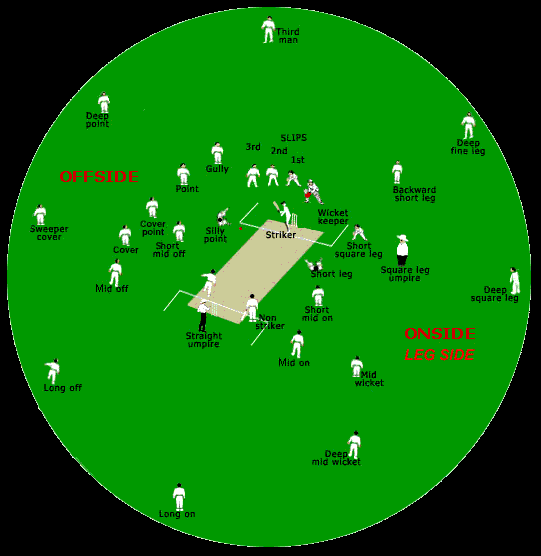
Look closely.. These are the conventional fielding positions that the captains of the bowling teams use to place their fielders. Just have a look at the areas in the field where fielders can have close catches and pull off fabulous stops in the boundary lines etc. Here there are 24 fielders ( EXCLUDING BOWLER and WICKET KEEPER) to explain the fielding positions. But, in real games there are only 9 fielders and the captain has a tough task of placing them in the right spots.
Any questions about the game of cricket (if you find it interesting) can be e-mailed to me at r.arunan@gmail.com .. I will be happy to answer them.
download the CRICKET LAW BOOK in PDF format here. (courtesy: Marylebourne Cricket Club, Lord's, London)
references